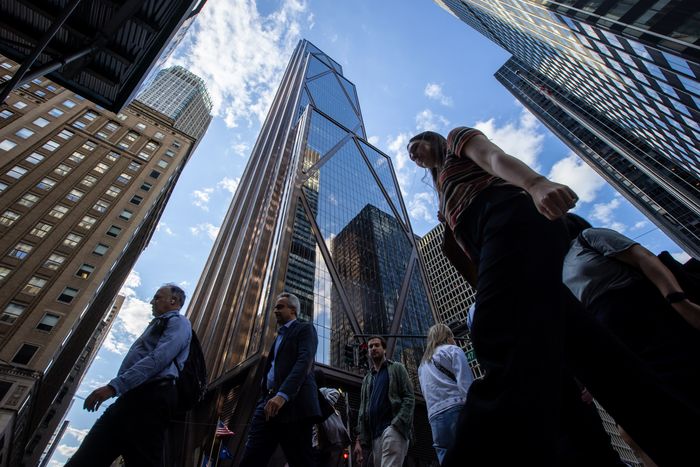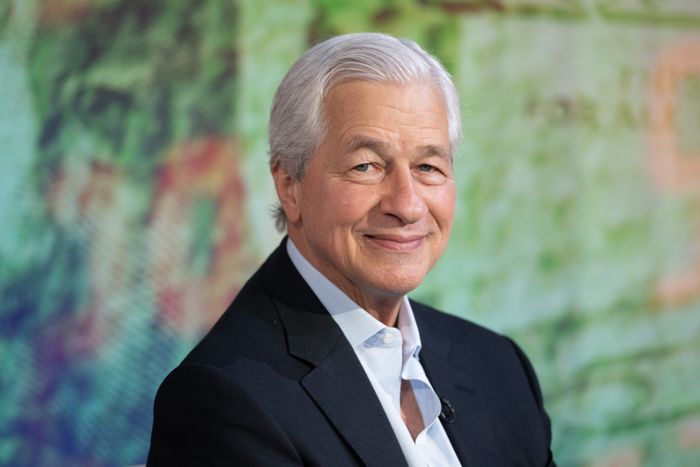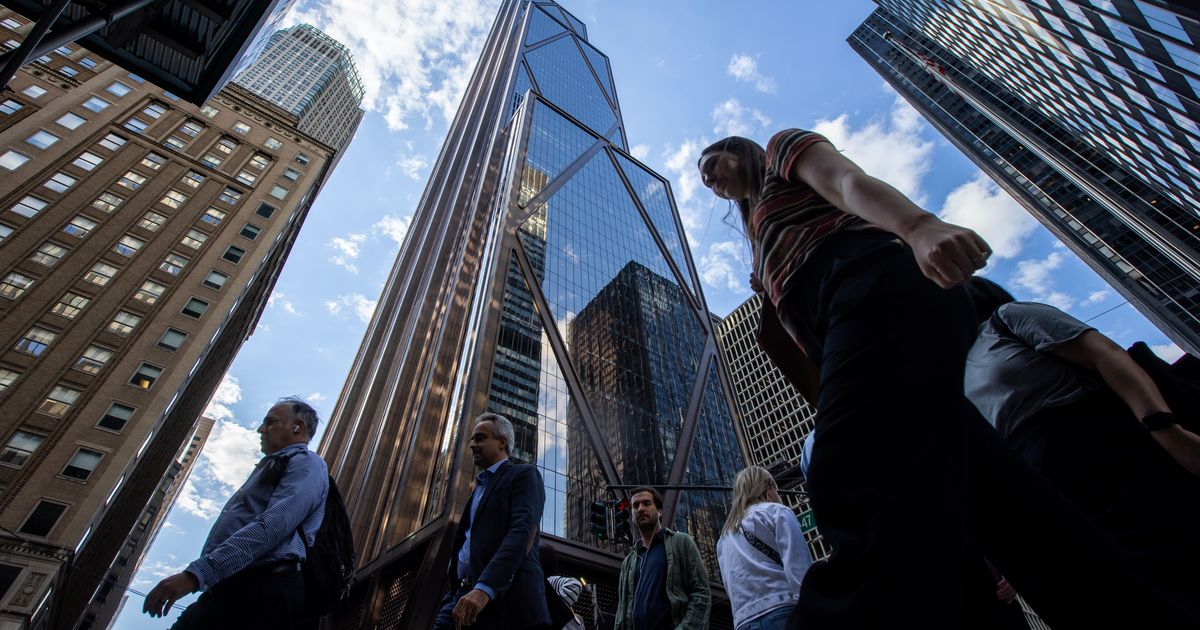
The new JPMorgan headquarters at 270 Park are just the centerpiece of a burgeoning Midtown East campus the bank is amassing.
Photo: Michael Nagle/Bloomberg/Getty Images
Employees started moving in to JPMorgan’s new megaskyscraper at 270 Park a few months ago, but it officially opens later this month. And while the 60-story, Norman Foster–designed tower has been described as a symbol of return to office and the revival of midtown Manhattan, it’s more of an outlier than a bellwether of the office market. Not only is the tower an unusually luxe space for the 10,000 bankers who’ve been mandated to return to work there, it’s the centerpiece of something even more ambitious: Jamie Dimon’s multi-block midtown campus, as Bloomberg reports. Not everyone can afford to do this, and indeed, most companies are not — its scale reflects JP Morgan’s dominant position in the banking industry — it’s not just a top-tier bank, it is the top bank, earning more profit last year than any lender in the history of American finance.
The other buildings in Dimon’s campus, or “JP Morgan’s own neighborhood,” as Bloomberg puts it, include the old Bear Stearns offices across the street at 383 Madison Avenue, which is about to get a $1 billion renovation. The Madison Avenue office served as JPMorgan’s temporary headquarters while 270 Park was going up (the bank tore down its old headquarters to build 270, taking advantage of the Midtown East rezoning to go bigger). Then there’s 250 Park, which may become a hotel for colleagues, and all the other office space JPMorgan is leasing nearby, bringing the bank’s midtown total to just under 6 million square feet — nearly as much as Goldman Sachs has in all of North and South America, as Bloomberg reports. (By comparison, Amazon, which has been building its own Midtown East campus along the Bryant Park corridor, has just under 1 million square feet.) All of this expansion reflects a newer trend, mostly available to the tech and financial behemoths, of assembling ad-hoc campuses that keep workers close together, and Google is perhaps the first company to spread the Silicon Valley model to Manhattan, sprawling out from its Chelsea headquarters at 111 Eighth Avenue to Chelsea Market in 2018, then adding space at Pier 57 and, most recently, another 1.3 million square feet at St. John’s Terminal, the long vacant freight terminal it bought and renovated, in Hudson Square. While companies are still renting less office space than they did before the pandemic, the old practice of downsizing in Manhattan and plunking employees in cheaper space in the hinterlands has fallen out of favor, and now a flashy new Manhattan headquarters is seen as a symbol of relevance and corporate macht. To wit: IBM, which decades ago decamped to a leafy suburban campus in Armonk, is now taking five floors in One Madison for a Manhattan flagship.

Jamie Dimon, who has fought against work from home, also apparently hates office gyms.
Photo: Noam Galai/Getty Images
The perks and amenities at 270 Park are also next-level fancy, including coffee shops that learn employees’ order preferences, a food hall with 19 restaurants and desk-side delivery options, and an Irish pub that Bloomberg reports had specialty parts imported so it could serve a proper pint of Guinness. However, they’re not nearly lavish enough for some employees to make up for having to go back in person — last winter, 1,300 of them signed a petition against the back-to-the-office mandate. And this summer, the Post reported that some were miffed to learn that they would have to pay for the “cutting-edge fitness center” in the new tower. (Which is perhaps less surprising when you learn that Dimon didn’t even want a fitness center in the first place, according to Bloomberg: “Dimon was known to dislike in-office gyms and had to be persuaded to greenlight this one as part of a wellness floor.”) There will also be an in-office wellness center where employees can go for “sick visits, acute care, general medical advice, lab work, allergy-shot management, and international-travel preparation.” Windows that let in more light than typical office windows, indoor lighting timed to circadian rhythms, and conference rooms with adjustable temperature controls are among the other wellness-oriented features. Also, a signature JPMorgan scent will be piped through the building. (Although, as some employers have griped online, their homes offer plenty of customizable light, temperature, and scent options, including the ability to have no scent at all.)
There will be more along the theme of customization, including “generative artwork that comes to life and moves when guests walk past,” according to Fortune. And perhaps strangest of all, an indoor flagpole that will flutter in a direction corresponding to the wind outside. As The New Yorker reported, Foster designed four 40-foot-tall fluted bronze flagpoles, three of which are outside. The fourth flag, located in the lobby, will be moved by a column of air, determined by an anemometer measuring wind speed and direction on the top of one of the outdoor flagpoles. When there is no wind outdoors, it will, apparently, flutter anyway, so as not to look limp and zestless. As Foster put it: “part of the surreal effect. Slight disbelief.”
Sign Up for the Curbed Newsletter
A daily mix of stories about cities, city life, and our always evolving neighborhoods and skylines.
Vox Media, LLC Terms and Privacy Notice
Related

